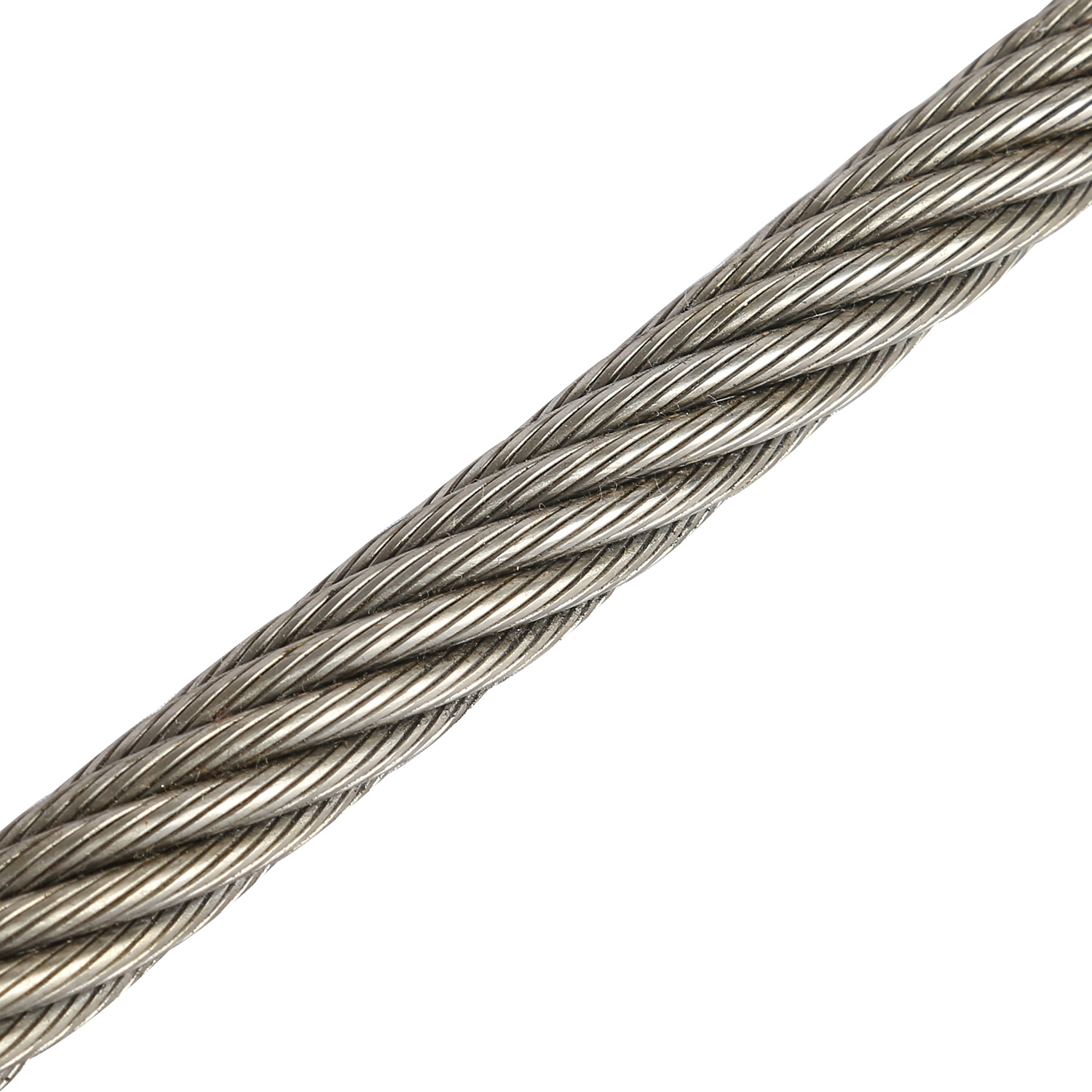Table of Contents
ลวดสลิงรีดแม่พิมพ์เป็นลวดสลิงชนิดหนึ่งที่ผลิตโดยใช้กระบวนการพิเศษที่เรียกว่าการรีดแม่พิมพ์ กระบวนการนี้เกี่ยวข้องกับการส่งเชือกลวดผ่านชุดลูกกลิ้งที่สร้างรูปร่างและอัดเชือกลวดให้อยู่ในรูปแบบสุดท้าย ผลลัพธ์ที่ได้คือลวดสลิงที่มีรูปร่างและขนาดสม่ำเสมอมากขึ้น โดยมีพื้นผิวที่เรียบเนียนกว่าเมื่อเทียบกับลวดสลิงแบบเดิม
ข้อดีหลักประการหนึ่งของลวดสลิงรีดด้วยแม่พิมพ์คือความแข็งแรงและความทนทานที่เพิ่มขึ้น กระบวนการรีดแม่พิมพ์ช่วยจัดแนวสายไฟแต่ละเส้นภายในเชือก ทำให้เกิดโครงสร้างที่กะทัดรัดและหนาแน่นมากขึ้น ส่งผลให้ลวดสลิงสามารถรับน้ำหนักได้ดีกว่าและทนต่อสภาวะแวดล้อมที่รุนแรง นอกจากนี้ พื้นผิวเรียบของลวดสลิงรีดด้วยแม่พิมพ์ช่วยลดการเสียดสีและการสึกหรอ ช่วยยืดอายุการใช้งานของเชือก
ลวดสลิงสแตนเลสเป็นตัวเลือกยอดนิยมสำหรับการใช้งานทางสถาปัตยกรรมเนื่องจากมีความแข็งแรง ความทนทาน และความสวยงาม ลวดสลิงสเตนเลสทนทานต่อการกัดกร่อน ทำให้เหมาะสำหรับการติดตั้งกลางแจ้งที่ต้องคำนึงถึงการสัมผัสองค์ประกอบต่างๆ นอกจากนี้ ลวดสลิงสเตนเลสยังมีให้เลือกใช้งานหลายประเภท ทั้งแบบขัดเงา ขัดเงา และเคลือบ ช่วยให้สถาปนิกและนักออกแบบได้รูปลักษณ์ที่ต้องการสำหรับโครงการของตน
เมื่อใช้เชือกลวดเหล็กในการใช้งานทางสถาปัตยกรรม สิ่งสำคัญคือ เพื่อพิจารณารัศมีการโค้งงอต่ำสุดของเชือก รัศมีการโค้งงอต่ำสุดคือรัศมีที่เล็กที่สุดที่สามารถดัดงอลวดสลิงได้โดยไม่ทำให้สายไฟแต่ละเส้นเสียหาย การดัดลวดสลิงเกินรัศมีการโค้งงอต่ำสุดอาจทำให้เกิดการหักงอ การแตกหัก และความเสียหายในรูปแบบอื่นๆ ที่เป็นอุปสรรคต่อความสมบูรณ์ของเชือก
ในการกำหนดรัศมีการโค้งงอขั้นต่ำของเชือกลวดเหล็กกล้า สิ่งสำคัญคือต้องพิจารณาปัจจัยต่างๆ เช่น เช่น เส้นผ่านศูนย์กลางของเชือก องค์ประกอบของวัสดุของเชือก และโครงสร้างของเชือก โดยทั่วไปแล้ว เชือกที่มีเส้นผ่านศูนย์กลางเล็กกว่าจะมีรัศมีการโค้งงอขั้นต่ำน้อยกว่าเมื่อเทียบกับเชือกที่มีเส้นผ่านศูนย์กลางใหญ่กว่า นอกจากนี้ เชือกที่มีจำนวนเส้นลวดมากกว่าและมีโครงสร้างที่กะทัดรัดมีแนวโน้มที่จะมีรัศมีการโค้งงอต่ำสุดที่น้อยกว่า
เมื่อติดตั้งเชือกลวดเหล็กในการใช้งานทางสถาปัตยกรรม สิ่งสำคัญคือต้องปฏิบัติตามแนวทางของผู้ผลิตในเรื่องรัศมีการโค้งงอเพื่อความปลอดภัยและอายุการใช้งานที่ยืนยาว ของเชือก หลีกเลี่ยงการงอเชือกเกินรัศมีการโค้งงอขั้นต่ำ และใช้เครื่องมือและเทคนิคที่เหมาะสมเพื่อให้เกิดการโค้งงอที่ราบรื่นและค่อยเป็นค่อยไป ด้วยการใช้ความระมัดระวังเหล่านี้ สถาปนิกและนักออกแบบสามารถมั่นใจได้ว่าการติดตั้งเชือกลวดเหล็กของตนมีทั้งประโยชน์ใช้สอยและสวยงาม
โดยสรุป เชือกลวดรีดแบบขึ้นรูปให้ประโยชน์หลายประการสำหรับการใช้งานทางสถาปัตยกรรม รวมถึงความแข็งแกร่ง ความทนทาน และความเรียบเนียนที่เพิ่มขึ้น การตกแต่งพื้นผิว ลวดสลิงสแตนเลสเป็นตัวเลือกยอดนิยมสำหรับโครงการสถาปัตยกรรม เนื่องจากมีความทนทานต่อการกัดกร่อนและสวยงาม เมื่อใช้เชือกลวดเหล็กในงานสถาปัตยกรรม สิ่งสำคัญคือต้องพิจารณารัศมีการโค้งงอขั้นต่ำของเชือก เพื่อป้องกันความเสียหายและรับประกันอายุการใช้งานของการติดตั้ง ด้วยการปฏิบัติตามแนวทางของผู้ผลิตและใช้เทคนิคที่เหมาะสม สถาปนิกและนักออกแบบจึงสามารถสร้างการติดตั้งเชือกลวดเหล็กที่ปลอดภัยและดึงดูดสายตาได้
Mould rolled wire Rope is a type of wire rope that is manufactured using a specialized process known as mould rolling. This process involves passing the wire rope through a series of rollers that shape and compress the wire rope into its final form. The result is a wire rope that is more uniform in shape and size, with a smoother surface finish compared to traditional wire ropes.
One of the key benefits of mould rolled wire rope is its increased strength and durability. The mould rolling process helps to align the individual wires within the rope, creating a more compact and dense structure. This results in a wire rope that is better able to withstand heavy loads and harsh environmental conditions. In addition, the smooth surface finish of mould rolled wire rope reduces friction and wear, extending the lifespan of the rope.
Stainless Steel wire rope is a popular choice for architectural applications due to its strength, durability, and aesthetic appeal. Stainless steel wire rope is resistant to corrosion, making it ideal for outdoor installations where exposure to the elements is a concern. In addition, stainless steel wire rope is available in a variety of finishes, including polished, brushed, and coated, allowing architects and designers to achieve the desired look for their projects.
When using steel wire rope in architectural applications, it is important to consider the minimum bending radius of the rope. The minimum bending radius is the smallest radius at which the wire rope can be bent without causing damage to the individual wires. Bending the wire rope beyond its minimum bending radius can Lead to kinks, breaks, and other forms of damage that compromise the integrity of the rope.
To determine the minimum bending radius of a steel wire rope, it is important to consider factors such as the diameter of the rope, the material composition of the rope, and the construction of the rope. In general, smaller diameter ropes have a smaller minimum bending radius compared to larger diameter ropes. Additionally, ropes with a higher number of wires and a compact construction tend to have a smaller minimum bending radius.
When installing steel wire rope in architectural applications, it is important to follow the manufacturer’s guidelines for bending radii to ensure the Safety and longevity of the rope. Avoid bending the rope beyond its minimum bending radius, and use proper tools and techniques to achieve smooth, gradual bends. By taking these precautions, architects and designers can ensure that their steel wire rope installations are both functional and aesthetically pleasing.
In conclusion, mould rolled wire rope offers a number of benefits for architectural applications, including increased strength, durability, and a smooth surface finish. Stainless steel wire rope is a popular choice for architectural projects due to its corrosion resistance and aesthetic appeal. When using steel wire rope in architectural applications, it is important to consider the minimum bending radius of the rope to prevent damage and ensure the longevity of the installation. By following manufacturer guidelines and using proper techniques, architects and designers can create safe and visually appealing steel wire rope installations.


